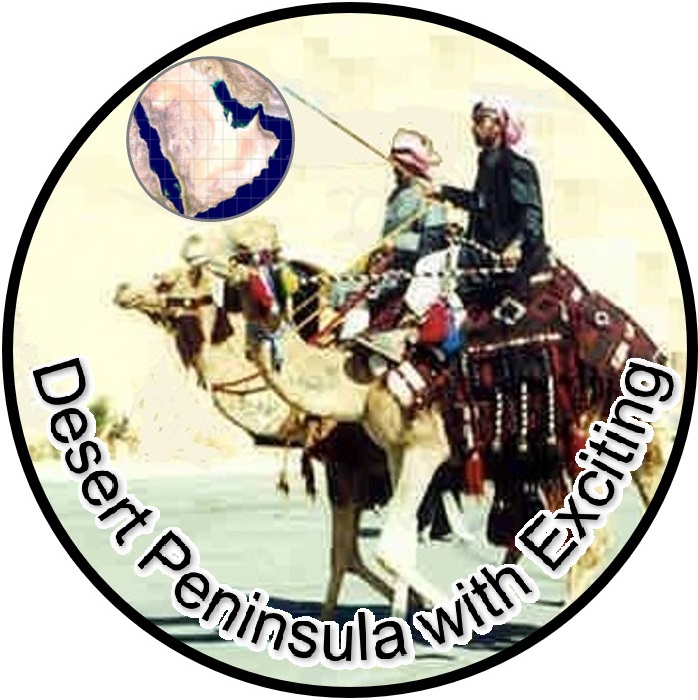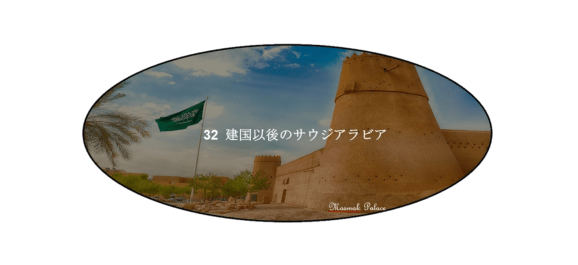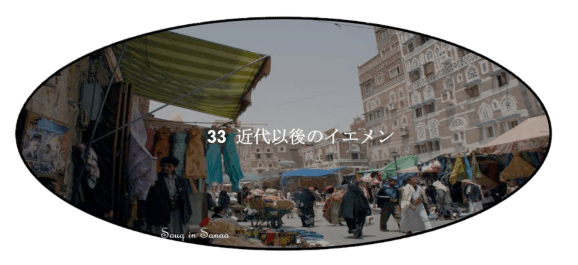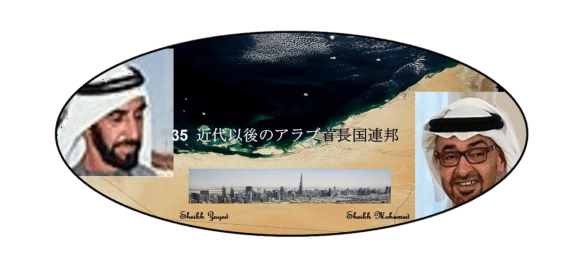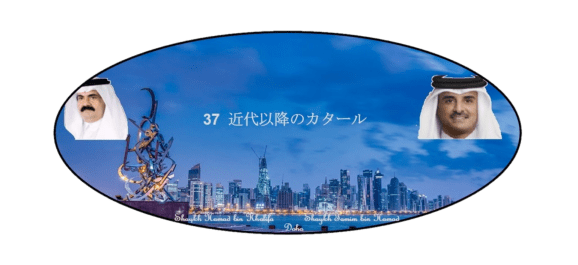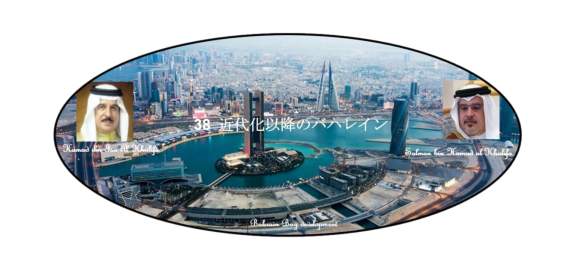Origin of Current Peninsula Nations
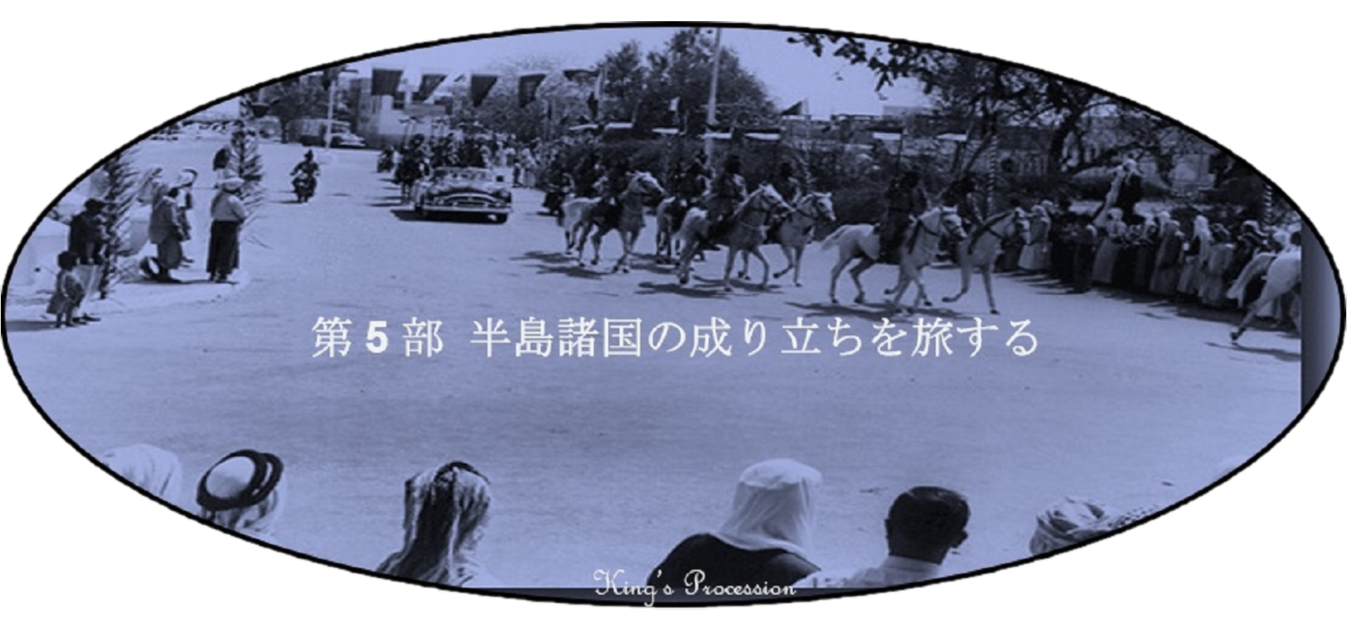
「第5部 半島諸国の成り立ちを旅する」では、現代のアラビア半島がイスラーム主義とアラブの春、イラン革命、イスラム過激派運動の影響を受けるだろうと予測していました。 それらの結果は、ある程度を除いて、それほど深刻ではありませんでした。それでも、バハレインは依然としてその影響を受けており、イエメンでは表面的な政治的和平合意が成立したにもかかわらず、三者ないし四者による内戦が依然として続いています。 しかし、その一方で、サウジアラビアに代表され、アラブ首長国連邦とカタールがそれに続く様に絶対王政が強化され、女性解放などの社会改革や経済発展に沿った制度改革が推進されてきました。 そして、成果も得られています。 このように、この半島では絶対王政による改革発展が主流になっていくのかも知れません。
これに伴い、第5部の章構成を変更し、イスラーム教の出現から現在までの可能な限り状況や出来事を紹介するようにしました。 第 5 部の第 8 章を次のように改訂および再構成しました。これに思いの外時間が掛かってしまいました。
In Part 5 “Origin of Current Peninsula Nations”, it was predicted that the modern Arabian Peninsula will be influenced by Islamism & Arab Spring, Iranian Revolution and post-Islamic extremist movements. The consequences from them, were not very much serious, except to some extent. Nevertheless, Bahrain is still affected by them, and in Yemen despite a superficial political peace agreement reached, Yemen’s three- or four-way civil war still continues. However, on the other hand, as represented by Saudi Arabia, followed by United Arab Emirates and Qatar, the absolute monarchies have been strengthened, and promoted their social reforms such as women’s emancipation and institutional reforms with countermeasures for economic development have been promoted. And some fruitful results have already been gotten. In this way, it might likely be that the reform and development by the absolute monarchy become the mainstream of this peninsula.
Accordingly, the chapter structure of Part 5 has been changed to introduce as situations and events as much as possible from the advent of Islam to the present. Chapter 8 of Part 5 were revised and reorganized as follows. It took sometime unexpectedly.
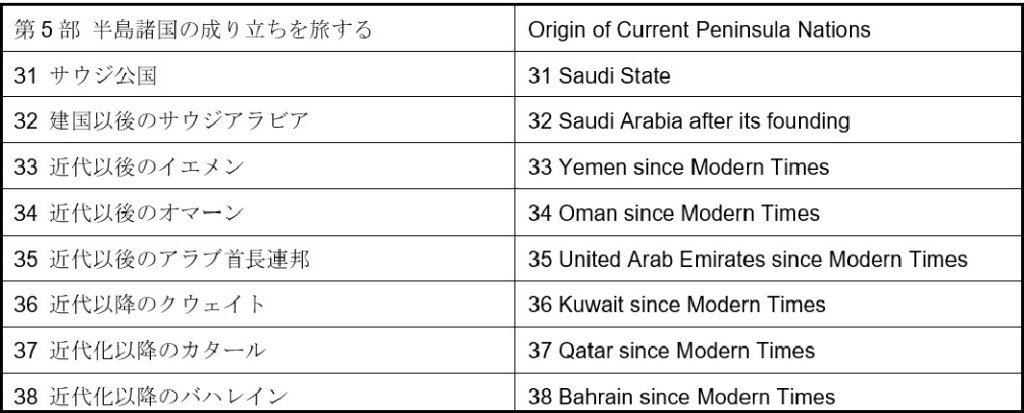
目次(Index)
イラン革命とイスラーム主義の台頭
Iranian Revolution and Rise of Islamism
節索引(Section Index)
イスラーム主義
Islamism
イスラーム世界は、ムハンマド(Muhammad) (محمد)が622年に聖遷してイスラーム帝国(Islamic Empire / Islamic caliphate) (خلافة إسلامية)を創設して以来、正統4カリフ時代 (the four Rashidun caliphates) (632~661) (الخلفاء الراشدين الأربعة)、ウマイヤ朝(Umayyad dynasty) (661~750) (الخلافة الأموية)、アッバース朝(Abbasid dynasty) (750~1258) (الخلافة العباسية)、マムルーク朝(Mamluks Sultanate) (1250~1517) (الدولة المملوكية)、オスマン帝国Ottoman Empire (1299~1922) (الدولة العثمانية)と政権は変わっていますが、クルアーンQuran (القرآن)に基づく統治がなされて来ました。
Since Muhammad (محمد) became Holy and established Islamic Empire (Islamic caliphate) (خلافة إسلامية) in 622, Islamic world had changed from the four Rashidun caliphates (632-661) (الخلفاء الراشدين الأربعة), Umayyad dynasty (661-750) (الخلافة الأموية), Abbasid dynasty (750-1258) (الخلافة العباسية), Mamluks Sultanate (1250-1517) (الدولة المملوكية), and Ottoman Empire (1299-1922) (الدولة العثمانية). There has been a rule based on Quran (القرآن).
クルアーンには信仰についてだけでは無く、政治と社会についても述べられ、それに基づくシャリーア(Shari’a) (الشريعة)法の恩恵でイスラーム帝国内であれば地域や人種に関係なく同じ法律や規範が適用されて来ました。第一次大戦(World War I) (1914~1918)でオスマン帝国が崩壊した後、100年足らずの間に1,300年続いたウンマ・イスラーミーヤ(Ummah Islam) (أمة إسلام)に変わる社会秩序が確立されたとは言えず、西洋の近代的思想や科学を取り入れた民主主義を志向する試行錯誤が続き、その中から生まれたのがイスラーム主義(Islamism) (إسلاموية)と云う概念です。
Quran speaks not only about faith, but also about politics and society, and thanks to Shari’a (الشريعة) law based on it, the same laws and norms have been applied within Islamic Empire regardless of region or race. After the collapse of Ottoman Empire in World War I, it cannot be said that a social order that replaced Ummah Islam (أمة إسلام) continued for 1,300 years in less than 100 years was established, and trial and error aimed at democracy incorporating modern Western thought and science continued, and the concept of Islamism (إسلاموية) was born out of it.
イラン出身のイスラーム活動家ジャマールッディーン・アフガーニー(Jamal-ud-Din Afghani) (1838/1839~1897) (جمال الدين الأفغاني)は、「後世のシャリーア法解釈では無く、イスラーム発祥当初の純粋なイスラームを求めることで西洋近代社会が生み出した思想や科学を取り入れた政治や社会の実現が可能になる」との「イスラーム改革思想(Islamic reform ideology) (عقيدة الإصلاح الإسلامي)”」を掲げ、絶対的な君主制よりも立憲制の方が優れていると説きました。
Iranian Islamic activist Jamal-ud-Din Afghani (1838/1839~1897) (جمال الدين الأفغاني) advocated the “Islamic reform ideology (عقيدة الإصلاح الإسلامي)” that “it is possible to realize politics and society incorporating the ideas and sciences created by modern Western society by seeking pure Islam at the beginning of the Islamic origin, not the interpretation of Shari’a law of later generations,” and argued that constitutional systems are superior to absolute monarchies.
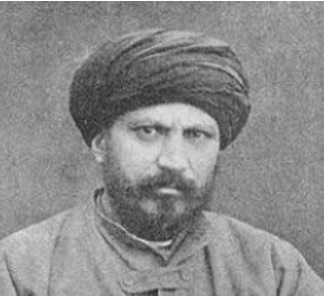
ジャマールッディーン・アフガーニー(Jamal-ud-Din Afghani)
この為、西洋列強からも警戒され、オスマン帝国に捕縛されて1897年に獄死しましたが、1884年に雑誌「固い絆(Strong Bonds)」を発刊して自身の思想を広めました。その共同執筆者がエジプト出身のムハンマド・アブドゥフ(Muhammad Abdukh) (1849~1905) (محمد عبده)であり、1881年にエジプトで起きた反英独立を掲げるウラービー運動(Ulabi movement) (1879~1882) (الثورة العرابية)に参加して一時追放されていましたが、帰国を許された後にムフティー(Mufti) (مفتي)(上位の宗教指導者)に就任しました。
For this reason, he was also wary of the Western powers, and although he was captured by Ottoman Empire and died in prison in 1897, he published the magazine “Strong Bonds” in 1884 to spread his ideas. Its co-author was Muhammad Abdukh (1849~1905) (محمد عبده) from Egypt, who founded the anti-British independence Ulabi movement (الثورة العرابية) (1879~1882) in Egypt in 1881. He was temporarily expelled for participating in mufti (مفتي) (an Islamic jurist), but after being allowed to return home, he became a Mufti (senior religious leader).
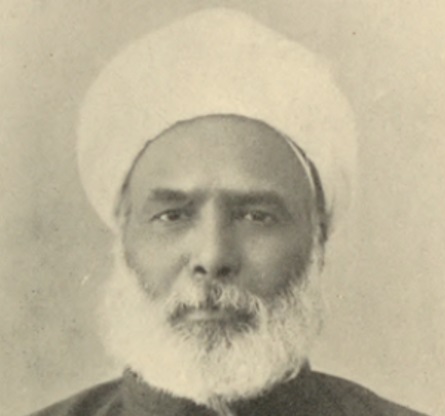
ムハンマド・アブドゥフ(Muhammad Abdukh)
アブドゥフはシリア出身で、最も影響力のある法学者ムハンマド・ラシード・リダー(Muhammad Rashid Ridah) (1865~1935) (محمد رشيد رضا)と雑誌「マナール(灯台)”Manar” (Lighthouse) (المنار مجلة)」を創刊して「純粋なイスラーム」を説く為に「サラフ(Salaf) (سلف)と呼ばれるイスラーム初期(聖遷からの3世代)を模範としてシャリーア法解釈の原点を習う」と云う「サラフィー主義思想(Salafi thought) (السلفية)」の理論化が行い、シリアのアラブ民族主義思想家アブドゥルラフマーン・カワーキビー(Abdulrahman Qawakibi) (c.1854~c.1902) (عبد الرحمن الكواكبي)やレバノン出身のドゥルーズ派(Druze) (الدرزية)知識人シャキーブ・アル=スラーン(Shaqeb al-Slan) (شقيب السلان).等多くの共感者を得ました。雑誌「固い絆」と「マナール(Manar) (المنار مجلة)」の発行を通じて、「イスラーム改革思想(Islamic reformism) (إصلاح إسلامي)」すなわち「イスラーム主義(Islamism) (إسلاموية)”」の概念が確立されたと考えられています。
Abdukh is from Syria and founded the magazine “Manar” (Lighthouse) (المنار مجلة) with the most influential jurist Muhammad Rashid Ridah (1865~1935) (محمد رشيد رضا), and in order to preach “pure Islam”, he theorized “Salafist thought (السلفية)” that says “learn the origin of Shari’a legal interpretation using the early Islamic period called Saraf (سلف) (three generations from the Holy Transfer) as a model”. He gained many sympathizers, including Syrian Arab nationalist thinker Abdulrahman Qawakibi (c.1854~c.1902) (عبد الرحمن الكواكبي) and Lebanese-born Druze (الدرزية) intellectual Shaqeb al-Slan (شقيب السلان). Through the publication of the magazines “Strong Bonds” and “Manar (المنار مجلة)”, the concept of “Islamic reformism (إصلاح إسلامي)” or “Islamism (إسلاموية)” is thought to have been established.
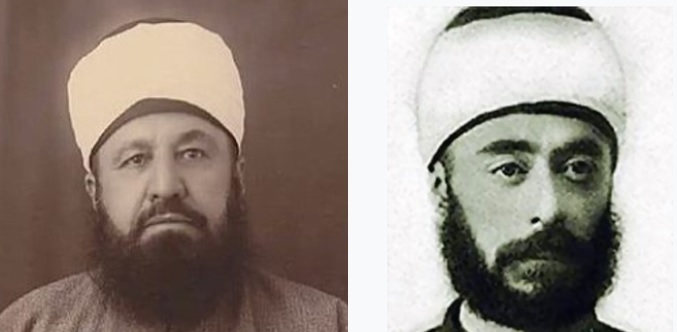
ムハンマド・ラシード・リダーとアブドゥルラフマーン・カワーキビー
(Muhammad Rashid Ridah and Abdulrahman Qawakibi)
1928年にハサン・バンナー(Hasan Banna) (1906~1949) (حسن البنا)がエジプトで「ムスリム同胞団(Muslim Brotherhood) (الإخوان المسلمون)」を結成して、アフガーニー(Jamal al-Din al-Afghani) (جمال الدين الأفغاني)、アブドゥ(Muhammad Abduh) (محمد عبده)とリダー(Muhammad Rashid Ridah) (محمد رشيد رضا)によって確立された「イスラーム主義」の概念をイスラーム復興運動組織として実践しました。当初は国家権力を直接には目指さず、モスクの建設・運営、医療奉仕活動、教育、学生・女性・労働者の組織化等の社会運動を行っていましたが、1948年に非合法化されたことで国家権力と対決することとなり、バンナも1949年には、国家権力を目指しませんでしたが、数年後に暗殺されました。「ムスリム同胞団(Muslim Brotherhood)」は、パレスチナでは「ハマース(Hamas) (حركة حماس)」、レバノンでは「イスラーム集団(Islamic Group)」、イラクでは「イスラーム党(Islamic Party)」の別名で活動していますし、中東以外でも関連団体があります。1950~1960年代に「ムスリム同胞団(Muslim Brotherhood)」を理論的に指導したのがサイイド・クトゥブ(Sayyid Qutb) (1906~1966) (سيد قطب)でした。クトゥブはイスラーム法が正しく施行されていない現代を「無明時代(Age of Ignorance) (jahiliyah) (جاهلية)」として「ムスリム同胞団(Muslim Brotherhood)」を弾圧する支配者を悪とし、改心させなければならないとしましたが、ムスリム同士が武装闘争やテロを行う事は認めていませんでした。
In 1928, Hasan Banna (1906~1949) (حسن البنا) formed “Muslim Brotherhood (الإخوان المسلمون)” in Egypt and put into practice the concept of “Islamism” established by Jamal al-Din al-Afghani (جمال الدين الأفغاني), Muhammad Abduh (محمد عبده) and Muhammad Rashid Ridah (محمد رشيد رضا) as an Islamic revival movement organization. Initially, it did not directly aim at state power, but carried out social movements such as building and operating mosques, medical service activities, education, and organizing students, women, and workers, but when it was outlawed in 1948, it came to confront state power, and Banna also did not aim at state power in 1949. was assassinated in years. Muslim Brotherhood operates under the alias Hamas (حركة حماس) in Palestine, Islamic Group in Lebanon, Islamic Party in Iraq, and has affiliates outside Middle East. In 1950s and 1960s, the theoretical leader of Muslim Brotherhood was Sayyid Qutb (1906~1966) (سيد قطب). Qutb regarded the present age when Islamic law was not properly enforced as the “Age of Ignorance” (jahiliyah (جاهلية)) and said that rulers who oppressed “Muslim Brotherhood” should be evil and converted, but he did not allow Muslims to engage in armed struggle or terrorism.

サイイド・クトゥブ(Sayyid Qutb)
シーア派のイスラーム主義
Islamism of Shia Islam
一方、シーア派(Shia Islam) (شيعة)のイスラーム主義(Islamism) (إسلاموية)は、「イスラーム法学者(ウラマー(‘ulamas) (علماء))が自ら主導して国家を治めるべき」と、まずイラクのイスラーム・ダアワ党(Islamic Da’wa Party) (حزب الدعوة الإسلامية)の主要な支持者ムハンマド・バーキル・サドル(Mohammed Bakir Sadr) (1935~1980) (محمد باقر الصدر),が主張しました。
Shiite Islamism, on the other hand, “should be led by Islamic jurists (‘ulamas (علماء)) to govern the state,” first argued by Mohammed Bakir Sadr (1935~1980) (محمد باقر الصدر), a leading supporter of Islamic Da’wa Party (حزب الدعوة الإسلامية) in Iraq.
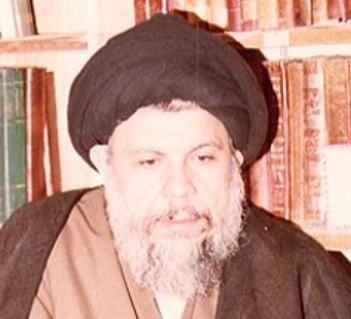
ムハンマド・バーキル・サドル(Mohammed Bakir Sadr)
これは、いずれもシーア派大アーヤトッラー(Shiite Great Ayatollahs) (آيات الله العظمى الشيعة)であったイラクのムハンマド・シーラーズィー(Muhammad Shirazi) (1928~2001) (محمد الحسيني الشيرازي)、サーディク・サドル(Sadiq Sadr) (1943~1999) (محمد صادق الصدر)やレバノンのムハンマド・フサイン・ファドルッラー(Muhammad Husayn Fadrullah) (1935~2010) (محمد حسين فضل الله)等のシーア派法学者に共通した概念でした。イラクのイスラーム・ダアワ党(Islamic Da’wa Party)は、弾圧によって何度も解散しかけましたが、イランのルーホッラー・ホメイニー師(Ruhollah Khomeini) (1900~1989) (روحالله خمینی)がイスラーム主義運動を展開しました。
This was a concept common to Shia grand Ayatollahs (آيات الله العظمى الشيعة) such as Muhammad Shirazi (1928~2001) (محمد الحسيني الشيرازي) and Sadiq Sadr (1943~1999) (محمد صادق الصدر) of Iraq and Muhammad Husayn Fadrullah (1935~2010) (محمد حسين فضل الله) of Lebanon, who were all Shia Grand Ayatollahs Islamic Da’wa Party in Iraq was repeatedly disbanded by repression, but Iranian Sheikh Ruhollah Khomeini (1900~1989) (روحالله خمینی) launched an Islamist movement.
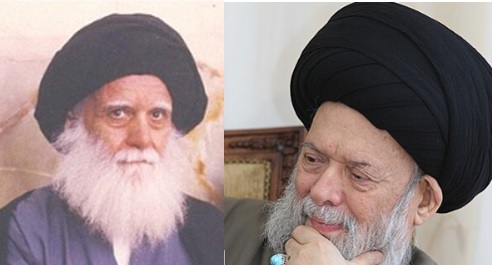
サーディク・サドルとムハンマド・フサイン・ファドルッラー
Sadiq Sadr and Muhammad Husayn Fadrullah
イラン革命
Iranian Revolution
ホメイニー師は、パフラヴィー朝(Pahlavi dynasty) (1925–1979) (قصر بهلوي)の脱イスラームと西洋化を目指す強権的な「白色革命(White Revolution) (ثورة بيضاء)」を批判して1964年に国外追放されました。皇帝(Emperor) (1941~1979)モハンマド・レザー(Mohammed Reza) (1919~1980) (محمد رضا بهلوي)は、1978年の全国的な反政府デモと軍隊の衝突に対する収拾が出来ず、翌1979年1月に亡命しました。2月に国外からも運動を続けていたホメイニー師(Sheikh Khomeini) (شيخ الخميني)がイランに戻って「イスラーム共和制(Islamic Republic) (1979~present) (جمهورية إسلامية)”」を樹立し、法学者が国家を治めるシーア派(Shia Islam) (شيعة)のイスラーム主義(Islamism) (إسلاموية)を実践しました。
Khomeini was deported in 1964 for criticizing the authoritarian “White Revolution (ثورة بيضاء)” aimed at the de-Islam and westernization of Pahlavi dynasty (1925–1979) (قصر بهلوي). Emperor (1941~1979) Mohammed Reza (1919~1980) (محمد رضا بهلوي) was unable to control the nationwide anti-government demonstrations and clashes of the armed forces in 1978 and went into exile in January 1979. In February, Sheikh Khomeini (شيخ الخميني), who had been campaigning from abroad, returned to Iran to establish an “Islamic Republic (1979~present) (جمهورية إسلامية)” and practiced Shia Islamism, in which jurists ruled the state.
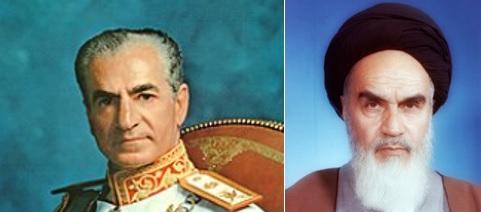
モハンマド・レザーとルーホッラー・ホメイニー
Emperor Mohammed Reza and Ruhollah Khomeini
このイラン革命Iranian Revolution (الثورة الإسلامية في إيران)と呼ばれる国家体制では三権分立の選挙で選ばれる政府の上にそれを監督する元首としての「最高指導者(Supreme Leader) (المرشد الأعلى للثورة الإسلامية)」、最高指導者を選任する「専門家会議(Council of Experts) (مجلس خبراء القيادة」およびシャリーア法との整合性を審査する「監督者評議会(Council of Supervisors) (مجلس نظارت بر مقام رهبری)」が設けられています。
In this state system called Iranian Revolution (الثورة الإسلامية في إيران), on top of the elected government of the separation of powers, there is a “Supreme Leader (المرشد الأعلى للثورة الإسلامية)” as the head of state to supervise it, a “Council of Experts (مجلس خبراء القيادة)” to appoint a Supreme Leader, and a “Council of Supervisors (مجلس نظارت بر مقام رهبری)” to examine consistency with Shari’a law.
イラン自体は、ホメイニー師の厳格なシーア派イスラーム主義と反米主義の為、イラン革命から40年近く経った現在でも周辺のアラブ諸国、特にスンナ派主体のアラビア半島諸国から「革命の輸出(Revolutionary exports) (تصدير الثورة)」に対して警戒され、米国とは硬軟あるにせよ依然として対立しています。
Iran is still at odds with United States, albeit hard, and soft, because of Khomeini’s strict Shia Islamism and anti-Americanism, even now, nearly 40 years after Iranian revolution, it is still wary of “Revolutionary exports (تصدير الثورة)” from neighboring Arab countries, especially Sunni-dominated countries of Arabian Peninsula.
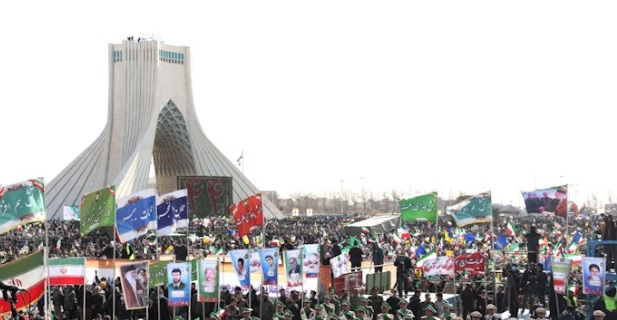
イラン革命(Iranian Revolution)
イラン革命の時点では周辺諸国のシーア派政権は、シリアのみでしたが、サッダーム・フセイン(Saddam Hussein) (صدام حسين)政権(1979~2003)が崩壊した後、選挙を通じてシーア派イスラーム・ダアワ党(Shia Islamic Da’wa Party)がイラク正統政権の主体と成りました。
At the time of Iranian Revolution, Syria was the only Shiite regime in neighboring countries, but after the fall of Saddam Hussein’s (صدام حسين) government (1979-2003), Shia Islamic Da’wa Party became the main body of Iraqi legitimate government through elections.
イエメンではシーア(Shia) (شيعة)派ハウシー(Houthis) (حوثيون)派が蜂起し、2015年のクーデターではハーディー(Hardi )(هادي)政権を崩壊させて暫定統治機構として大統領評議会を開設しました。
In Yemen, Shia (شيعة) Houthis (حوثيون) rose up, and in a 2015 coup, they overthrew Hadi government and established Presidential Council as an interim governing body.
ハーディー:アブド・ラブフ・マンスール・ハーディー
Hadi: Abd Rabbuh Mansur Hadi (r.2012~2022) (عبدربه منصور هادي)
スンナ派同盟軍の干渉(決定的嵐作戦(Operation Decisive Storm) (ملية عاصفة الحزم))でハーディー政権が復帰した後もハウシー派は、2016年に「救国政府(national salvation government) (حكومة الإنقاذ الوطني)」を樹立して対抗しています。
Even after the return of Hardi (هادي) government due to the intervention of Sunni alliance (Operation Decisive Storm (ملية عاصفة الحزم)), Houthis have responded by establishing a “national salvation government (حكومة الإنقاذ الوطني)” in 2016.
イスラーム過激派
Islamic extremists
節索引(Section Index)
| イスラーム過激派の発祥 | Origin of Islamic extremism |
| ムジャーヒディーン | Mujahideen |
| アルカーイダ | Al-Qaeda |
| 米国主導有志連合 | U.S.-led coalition |
| イスラーム国 | Islamic State |
| 勢力の衰えたアルカーイダ | Al Qaeda in decline |
イスラーム過激派の発祥
Origin of Islamic extremism
サイイド・クトゥブSayyid Qutb (1906~1966) (سيد قطب)が1966年に処刑されると、主としてスンナ派(Sunnis9 (أهل السنة)のイスラーム主義者(Islamists) (اسلامي)の中に「サイイド・クトゥブは武装闘争やテロを認めた」と云う誤った理解をする者達が現われました。この者達が1970年代以降、強力に軍備を固めたイスラエルへの抵抗組織であるハマース(Hamas) (حماس)やヒズボッラー(Hezbollah) (حزب الله)を見習って「自爆テロ」も辞さない苛烈な戦闘テロ組織となり、イスラーム過激派(Islamic extremists) (تطرف إسلامي)と呼ばれるようになりました。
After Sayyid Qutb (1906~1966) (سيد قطب) was executed in 1966, there were some Islamists (اسلامي), mainly Sunnis (أهل السنة), who had a mistaken understanding that Sayyid Qutb admitted to armed struggle and terrorism. Since 1970s, these fighters have become fiercely hostile terrorist organizations that do not hesitate to commit “suicide bombings” by following in the footsteps of Hamas (حماس) and Hezbollah(حزب الله), which are strongly armed resistance groups against Israel, and have come to be called Islamic extremists (تطرف إسلامي).
1979年にはメッカ(Mecca) (مكة)の聖モスク(Holy Mosque) (المسجد الحرام)占拠事件が起こし、1981年にはエジプト大統領サーダート(Anwar Sadat) (r.1970~1981) (محمد أنور السادات)を暗殺しました。それでも、この時期は自国内での世直しを目的としていたので、イスラーム過激派(Islamic extremists)は、ジハード主義者(jihadists) (جهاديين)とも呼ばれていました。アラブ各国政府による弾圧や取り締まりの強化によって、イスラーム過激派は、隣国や西洋に亡命しましたが、一部にはジハード(jihad9 (جهاد)の実践自体に意義を見出して戦いの場を求める者達がいました。
In 1979, they took possession of Holy Mosque (المسجد الحرام) in Mecca (مكة), and in 1981 they assassinated Egyptian President Anwar Sadat (r.1970~1981) (محمد أنور السادات). Still, because this period was aimed at rehabilitating the world within their own country, Islamic extremists were also called jihadists(جهاديين). Increased repression and crackdown by Arab governments have led to Islamic extremists defecting to neighbouring countries and the West, but some have found meaning in the practice of jihad (جهاد) itself and sought a place to fight.
ムジャーヒディーン
Mujahideen
ソ連軍のアフガニスタン侵攻(1978~1989)は、その者達に「ウンマ・イスラーミーヤ(Ummah Islamiyya) (الأمة الإسلامية)」の共同体意識の下での戦いの場を与える機会を設ける事と成り、ソ連軍へのムスリム・抵抗ゲリラ(Muslim resistance guerrilla)であるムジャーヒディーン(Mujahideen) (مجاهدين)に加わる者も少なくありませんでした。
Soviet invasion of Afghanistan (1978~1989) gave them the opportunity to fight under the communal sense of “Ummah Islamiyya (الأمة الإسلامية) “, and many joined Mujahideen (مجاهدين), a Muslim resistance guerrilla against Soviet forces.
その中にサウジアラビアで大手の建設財閥御曹司ウサーマ・ビン・ラーディン(Osama bin Laden) (1957~2011) (أسامة بن لادن)やその理論面と作戦面を支えたエジプト人アイマン・ザワーヒリー(Ayman Zawahiri) (1951~2022) (أيمن الظواهري)いました。
Among them were Osama bin Laden (1957~2011) (أسامة بن لادن), a scion of Saudi Arabia’s leading construction conglomerate, and Ayman Zawahiri (1951~2022) (أيمن الظواهري), an Egyptian who supported its theoretical and operational aspects.

ウサーマ・ビン・ラーディンとアイマン・ザワーヒリー
Osama bin Laden and Ayman Zawahiri
アルカーイダ
Al-Qaeda
ビン・ラーディンが1990年に「英雄」として帰国すると、湾岸危機(Gulf Crisis) (August 2, 1990 ~ February 28, 1991) (حرب الخليج الثانية)が勃発しました。米国主導多国籍軍のサウジアラビア駐留に激しく反発したビン・ラーディンは、1992年に国を離れてアルカーイダ(al-Qaeda) (القاعدة)を結成しました。「イスラームを攻撃しているキリスト教徒の盟主」米国を敵として1998年のケニアとタンザニアでのアメリカ大使館爆破事件や2000年のイエメン沖の米艦コール襲撃事件等各地でテロ行為を実施し、2001年9月11日にアメリカ同時多発テロ事件を起こしました。
When Bin Laden returned home as a “hero” in 1990, Gulf Crisis (August 2, 1990 ~ February 28, 1991) (حرب الخليج الثانية) broke out. Bin Laden, who vehemently opposed the presence of a U.S.-led coalition force in Saudi Arabia, left the country in 1992 to form al-Qaeda (القاعدة). Targeting United States, the “leader of Christians attacking Islam”, U.S. carried out terrorist acts in various places, including the bombings of U.S. embassies in Kenya and Tanzania in 1998 and the attack on U.S. ship Cole off the coast of Yemen in 2000, and the terrorist attacks on United States occurred on September 11, 2001.
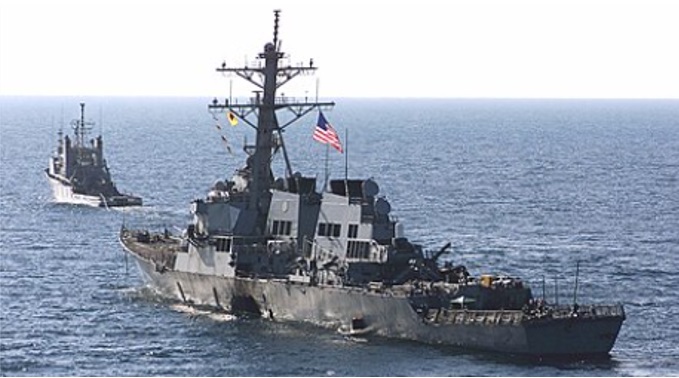
米艦コール(U.S. ship Cole)
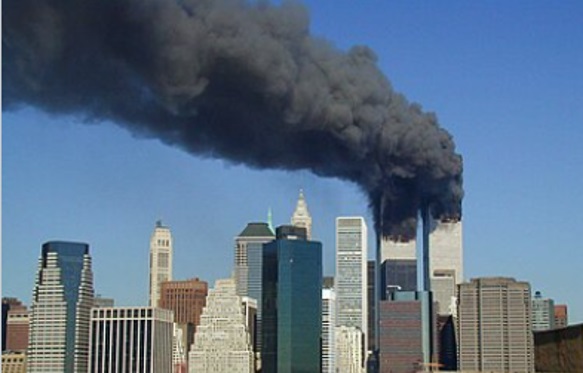
9月11日アメリカ同時多発テロ事件 (September 11 attacks)
その後もダーイシュ(Daesh) (داعش) (Islamic State (تنظيم الدولة الإسلامية))を含めてイスラーム過激派(Islamic extremists)の起こしたテロ事件は、主なものだけでもマドリード列車爆破テロ事件(2004年3月11日)、ロンドン同時爆破事件(2005年7月7日)、エジプト同時爆破テロ(2005年7月23日)、ムンバイ同時多発テロ(2008年11月26日)、ノルウェー連続テロ事件(2011年7月22日)、パリ同時多発テロ事件(2015年11月13日)、ブリュッセル連続テロ事件(2016年3月22日)、マンチェスター・コンサート会場自爆テロ(2017年5月23日)、バルセロナ・テロ事件(2017年8月17日)等が挙げられます。
Since then, the main terrorist incidents by Islamic extremists, including Daesh (داعش) (Islamic State (تنظيم الدولة الإسلامية)), include Madrid train bombing (March 11, 2004), London bombing (July 7, 2005), Egyptian bombing (July 23, 2005), Mumbai terrorist attacks (November 26, 2008), These include Norwegian terrorist attacks (July 22, 2011), Paris terrorist attacks (November 13, 2015), Brussels serial terrorist attacks (March 22, 2016), the suicide bombings at Manchester concert venue (May 23, 2017), and Barcelona terrorist attacks (August 17, 2017).

ダーイシュ(Daesh)
サウジアラビア国内に残ったビン・ラーディン信奉者は、厳しい取り締まりの為にイエメンに拠点を移し、イエメン支部と合同して「アラビア半島のアルカーイダ(al-Qaeda of the Arabian Peninsula) (تنظيم القاعدة في جزيرة العرب)」を名乗りました。単独でもテロを起こしていましたが、サーレハ元大統領派を含むアンサール・アル=シャリーア(Ansar al-Shari’a) (نصار الشريعة)(シャリーア法の戦士)に参加して、一時的にはアビヤン県(Abyan) (أبين)、ムカッラー県(Mukallah) (مكلا)やハドラマウト県(Mukallah) (مكلا)で領土を支配してハーディー大統領派(President Hadi)やハウシー派(Houthis) (حوثيون)との攻防を続けています。
The remaining Bin Laden followers in Saudi Arabia have moved to Yemen for a crackdown and have joined with Yemeni branch to call themselves “al-Qaeda of the Arabian Peninsula (تنظيم القاعدة في جزيرة العرب).” Although they had committed terrorism on their own, they had joined Ansar al-Shari’a (نصار الشريعة) (Shari’a law fighters), including former President Saleh, and had tentatively controlled territory in Abyan (أبين), Mukallah (مكلا) and Hadramout (حضرموت) governorates, and continues to fight against President Hadi and Houthis (حوثيون).
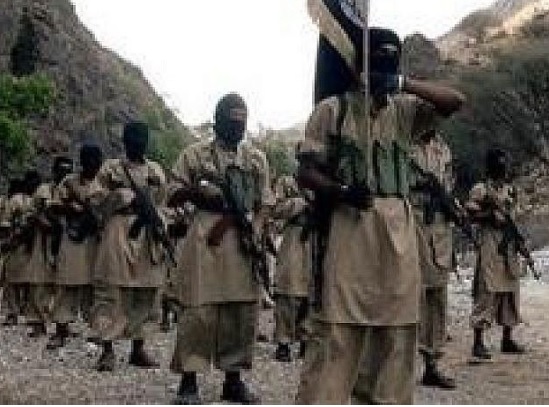
アラビア半島のアルカーイダ(al-Qaeda of the Arabian Peninsula)
サレハ大統領:アリ・アブダラ・サレハ(Ali Abdullah Saleh) (r.1978~1990, North Yemen) (r.1990~2012, Yemen) (علي عبدالله صالح)
President Saleh: Ali Abdullah Saleh (r.1978~1990, North Yemen) (r.1990~2012, Yemen) (علي عبدالله صالح)
ハーディー大統領:アブド・ラブフ・マンスール・ハーディー(Abd Rabbuh Mansur Hadi) (r.2012~2022) (عبدربه منصور هادي)
President Hadi : Abd Rabbuh Mansur Hadi (2012~2022) (عبدربه منصور هادي)
米国主導有志連合
U.S.-led coalition
アメリカ同時多発テロ事件首謀者ビン・ラーディンが隠れていたアフガニスタンのターリバーン(Taliban) (طالبان)政権がその引渡しに応じなかった為、米国主導有志連合が「不朽の自由作戦(Operation Enduring Freedom) (2001~2014) (عملية الحرية الدائمة)」の下にこれを打倒しましたが、ビン・ラーディンは、発見できず、新イスラーム共和国政府(New Islamic Republic)、ターリバーン残党を始めとする各派が対立するアフガニスタン紛争(Afghan conflict) (2001-2014) (النزاع في أفغانستان)が続きました。ビン・ラーディン自身は、2011年にパキスタンの隠れ家で米海軍特殊部隊に発見され、殺害されました。
U.S.-led coalition overthrew Taliban (طالبان) regime in Afghanistan, where Bin Laden was hiding from United States, under Operation Enduring Freedom (2001~2014) (عملية الحرية الدائمة), but Bin Laden could not be found, and Afghan conflict (2001-2014) (النزاع في أفغانستان) ensued, in which the government of New Islamic Republic, the remnants of Taliban, and other factions were at odds. Bin Laden himself was found and killed by U.S. Navy SEALs in a hideout in Pakistan in 2011.
イラク大統領サッダーム・フセイン(Saddam Hussein) (1979~2003) (صدام حسين)がビン・ラーディンに加担したとして、米国は、有志連合と共にイラク武装解除進展義務違反を理由とする「イラクの自由作戦(Operation Iraqi Freedom) (Iraq War) (2003~2011) (حرب العراق)」の名の下に2003年3月20日にイラク戦争へ突入しました。フセイン政権は、打倒されて占領下の2006年に正式政府が発足しましたが、アルカーイダ(al-Qaeda)やダーイシュ(Daesh)等のイスラーム過激派(Islamic extremists)との武装抗争が激しく、米軍の駐留は、2011年12月14日に戦争終結を正式に宣言するまで続きました。
With Iraqi President Saddam Hussein (1979~2003) (صدام حسين) acceding to bin Laden, United States, along with the coalition of the willing, entered Iraq War on March 20, 2003, under the name of “Operation Iraqi Freedom (Iraq War) (2003~2011) (حرب العراق)” on the grounds of violating Iraq’s obligation to progress in disarmament. Although Hussein’s regime was overthrown and a formal government was formed in 2006 during the occupation, armed conflict with Islamic extremists such as al-Qaeda and Daesh was intense. And the presence of U.S. troops continued until December 14, 2011, when the war was officially declared ended.
イスラーム国
Islamic State
アブー・ムスアブ・アッ=ザルカーウィー(Abu Musuab al-Zarqawi) (1966~2006)) (أبو مصعب الزرقاوي)がヨルダンで組織した「タウヒード(Tawheed) (توحيد)(イスラームにおける神の唯一性)とジハード(Jihad) (جهاد)(聖遷あるいは努力・奮闘)の集団」は、2004年にイラクでアルカーイダと合流して「イラクの聖戦アルカーイダ組織(Iraqi Jihad Al Qaeda Organization) (تنظيم قاعدة الجهاد في بلاد الرافدين)」と名乗りました。
“Tawheed (توحيد) (oneness of God in Islam (Allāh)) and Jihad (جهاد) (striving or struggling) Group” organized in Jordan by Abu Musuab al-Zarqawi (1966~2006)) (أبو مصعب الزرقاوي) joined al-Qaeda in Iraq in 2004 and called itself the “Iraqi Jihad Al Qaeda Organization (تنظيم قاعدة الجهاد في بلاد الرافدين).”
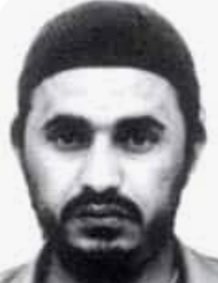
アブー・ムスアブ・アッ=ザルカーウィー(Abu Musuab al-Zarqawi)
2006年に外国人義勇兵を中心とした為にイラク民兵と衝突してアルカーイダとは分離し、ザルカーウィー(Zarqawi)が米軍爆撃で死亡して解散しました。再編してダーイシュ(Daesh) (داعش)を名乗り、イラク国内に領土を確保してアブー・ウマル・アル=バグダーディー(Abu Umar al-Baghdadi) (1959~2010) (أبو عمر البغدادي)が首長と成りました。その死亡後の2010年にアブー・バクル・アル=バグダーディー(Abu Bakr al-Baghdadi) (1971~2019) (أبو بكر البغدادي)が継承して「アラブの春(Arab Spring) (الربيع العربي)」で内戦状態となったシリアでも勢力を広げ、2014年にカリフ制国家の樹立を宣言しました。
In 2006, the group broke away from al-Qaeda after clashing with Iraqi militias to take center stage with foreign volunteers, and was disbanded after Zarqawi was killed in a U.S. bombing. It reorganized and took the name Daesh, securing territory in Iraq and becoming the chief of Abu Umar al-Baghdadi (1959~2010) (أبو عمر البغدادي). After his death, Abu Bakr al-Baghdadi (1971~2019) (أبو بكر البغدادي) succeeded him in 2010 and expanded his power in Syria, which was in a state of civil war during Arab Spring (الربيع العربي), and declared the establishment of a caliphate in 2014.
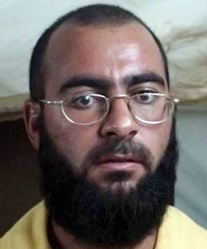
アブー・バクル・アル=バグダーディー(Abu Bakr al-Baghdadi)
旧フセイン政権も取り込んで国家組織を備え、一時は、大油田を含む日本の国土に匹敵する地域を統治していました。欧米、ソ連、トルコ、イランからの攻撃で勢力を削がれて、2017年7月には都市部で唯一残ったモスル(Mosul9 (موصل)もほぼ殲滅された。それでも、モスル以外のニナワ州、キルクーク (Kirkuk) (كركوك)、アンバル(Anbar) (أنبار)やラッカ(Raqqa) (رقة)は、依然としてダーイシュの支配していましたが、現在はほぼ力を失っています。
The former Hussein regime also co-opted the state, and at one time it ruled an area comparable to the Japan territory, including large oil fields. Attacks from the West, Soviet Union, Turkey and Iran had eroded its power, and in July 2017, Mosul (موصل), the only remaining urban area, was nearly wiped out. Nevertheless, other than Mosul, Ninawa provinces (محافظة نينوى), Kirkuk (كركوك), Anba r(أنبار) and Raqqa (رقة) had still been under Daesh’s control, but are now largely devoid of power.
勢力の衰えたアルカーイダ
Al Qaeda in decline
ビン・ラーディン(Bin Laden)が米軍に殺害された後は、アイマン・ザワーヒリー(Ayman Zawahiri)が指導者を引き継ぎ、イスラーム・マグレブ諸国(Islamic Maghreb) (بلاد المغرب الإسلامي)のアルカーイダやイラクの聖戦アルカーイダ(al-Qaeda in Iraq) (القاعدة في العراق)も活動してはいますが、勢力の衰えたアルカーイダには国際的に組織を維持する事は難しく、自爆も厭わない信奉者を個人的に啓発する運動が主に成っています。敗色の濃いダーイシュ(Daesh)の外国人傭兵も戦列を離れ、自国に戻って自爆テロ起こしましたし、ダーイシュに啓発された者も少なくありませんでした。
After Bin Laden was killed by U.S. troops, Ayman Zawahiri took over as leader, and although al-Qaeda (القاعدة) in Islamic Maghreb (بلاد المغرب الإسلامي) and al-Qaeda in Iraq (القاعدة في العراق) were active, it was difficult for the weakened al-Qaeda to maintain an organization internationally, and the movement became mainly to personally enlighten followers who were willing to blow themselves up. Foreign mercenaries from Daesh, who are heavily defeated, had also left the line and returned to their home countries to carry out suicide bombings, and many had been enlightened by Daesh.
イスラーム主義過激派(Islamic extremists) (متطرفين إسلامي)への取り締まりや弾圧を強化する程、これ等イスラーム過激派に対する新たな信奉者を生み、インターネット等で啓発されて都市ゲリラ的に自国を標的にした動きとなる悪循環が広がっていました。治安部隊や軍隊だけの力による対抗では済まず、イスラーム過激派を生み出す土壌への対策がこれまで以上に重要になりました。
The more the crackdown and repression of Islamic extremists (متطرفين إسلامي) was strengthened, the more a vicious cycle was spreading, giving rise to new followers of these Islamic extremists, enlightened by Internet and other means, and targeting one’s own country in an urban guerrilla manner. In the future, it will not be enough to counter with the power of security forces and the military alone, but it will be more important than ever to take measures against the soil that gives rise to Islamic extremism.
アラブの春とイエメン内戦
Arab Spring and Yemeni Civil War
節索引(Section Index)
| ジャスミン革命 | Jasmine Revolution |
| アラブの春の紛争 | Arab Spring Conflicts |
| イエメン内戦 | Yemeni Civil War |
| 融和の機運 | Trend of Reconciliation |
ジャスミン革命
Jasmine Revolution
チュニジア(Tunisia) (تونس),では1987年より長期政権を維持して来たベン・アリー大統領(President Ben Ali) (r. 1987~2011) (الرئيس بن علي),に対して2010年末に一族の利権独占や腐敗、さらに高失業率と物価高騰で国民の不満が高まっていました。失業中の若い学卒男性ブーアズィーズィー(Bouazizi) (بوعزيزي)が青物の露店を開いたところ、婦人警官に販売許可が無いと、商品を没収されました。これに抗議した焼身自殺を契機にベン・アリー政権(Ben Ali’s government)が崩壊する大規模な反政府デモが起りました。
In Tunisia (تونس), at the end of 2010, the public was growing dissatisfied with President Ben Ali (r. 1987~2011) (بن علي), who had been in power for a long time since 1987, due to the family’s monopoly on interests, corruption, high unemployment and soaring prices. Bouazizi (بوعزيزي), an unemployed young college graduate who opened a blue stall and was confiscated for goods by a policewoman without a license to sell it. The self-immolation in protest sparked massive anti-government demonstrations that led to the collapse of Ben Ali’s government.
ジャスミン革命(Jasmine Revolution)と呼ばれ、アラブ諸国では前例のない大きな反政府運動と成って2010年から2012年にかけて広がりました。一部を除いて武力に訴える事は無かったので「プラハの春(1968)」に習い、「アラブの春(Arab Spring) (الربيع العربي)」と呼ばれています。
Dubbed Jasmine Revolution, it became a major anti-government movement unprecedented in Arab countries and spread from 2010 to 2012. With the exception of a few, there was no resort to force, so it is called the “Arab Spring (الربيع العربي)” after the “Prague Spring (1968)”.
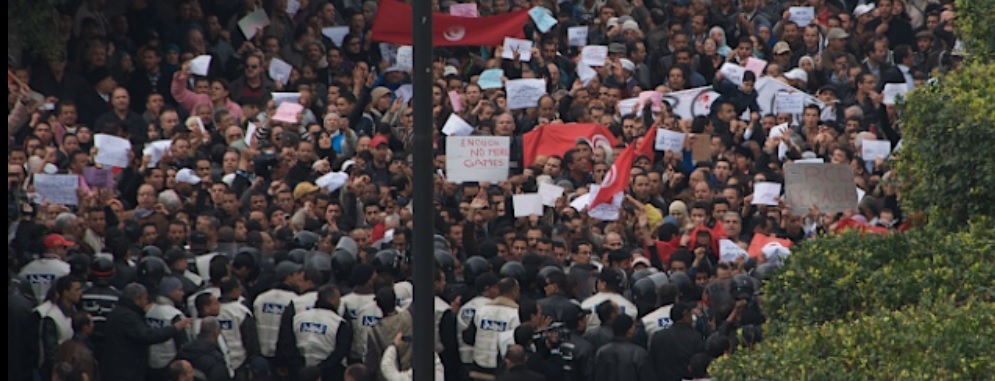
ジャスミン革命(Jasmine Revolution)
長期政権を維持して来た独裁者が倒され、それらの国での民主化の期待が高まったものの、国内の対立や衝突また民主主義的政治決定に対する不慣れさもあって、チュニジア(Tunisia) (تونس)を除いて独裁制に復帰するか、深刻な内乱状態となっています。その中でアラビア半島諸国は、内乱状態となった大統領制のイエメンを除いて君主制国家が比較的に安定感を見せました。しかし、内実はスンナ派とシーア派の対立が深まり、イスラーム過激派の潜在的な勢力が高まり、表向きの国民に対する融和政策と裏腹に政権の強権性が一層強まっている様に見えていました。
Although the dictators who have maintained long-term governments had been overthrown, and expectations for democratization in those countries had risen, domestic conflicts and clashes and unfamiliarity with democratic political decisions had led to a return to dictatorships or serious civil strife with the exception of Tunisia (تونس). In the countries of Arabian Peninsula, with the exception of Yemen, which had a presidential system that was in a state of civil war, the monarchical states showed a relatively stable state. However, in reality, the confrontation between Sunnis and Shiites has deepened, the potential power of Islamic extremists has risen, and the authoritarian power of the regime seems to be further strengthened despite the ostensible policy of reconciliation toward the people.
アラブの春の紛争
Arab Spring Conflicts
「アラブの春」では独裁者が長年に渡って政権を握ってきたチュニジアの他、1969年からのリビア・ガッザーフィー政権、1978年からのイエメン・サーレハ政権および1981年からのエジプト・ムバーラク政権等の長期独裁政権が打倒され、1970年から一党独裁のシリア・アサド政権は内乱状態に陥っていました。
In Arab Spring, in addition to Tunisia, where dictators have ruled for many years, long-term dictatorships such as Libyan Gaddafi regime from 1969, Yemeni Saleh regime from 1978, and Mubarak regime in Egypt from 1981 were overthrown, and Assad regime in Syria, which had been a one-party dictatorship since 1970, fell into a state of civil war.
| ガッザーフィー(Gaddafi):ムアンマル・ガッザーフィー(Muammar Gaddafi) (r.1969~2011) (معمر القذافي) | Gaddafi: Muammar Gaddafi (r.1969~2011) (معمر القذافي) |
| サーレハ(Saleh): アリ・アブダラ・サレハ(Ali Abdullah Saleh al-Ahmar) (NY r.1978~1990, Y r.1990 ~2012) (علي عبدالله صالح الأحمر) | Saleh: Ali Abdullah Saleh al-Ahmar (NY r.1978~1990, Y r.1990 ~2012) (علي عبدالله صالح الأحمر) |
| ムバーラク(Mubarak):ホスニー・ムバーラク(Hosni Mubarak) (r.1981~2011) (حسني مبارك) | Mubarak: Hosni Mubarak (r.1981~2011) (حسني مبارك) |
| アサド(Assad):ハーフィズ・アル=アサド(Hafez al-Assad) (pm1970~1971, r.1971~2000) (حافظ الأسد) アサド(Assad):バッシャール・アル=アサド(Bashar al-Assad) (r.2000~present) (بشار الأسد) | Assad: Hafez al-Assad (pm1970~1971, r.1971~2000) (حافظ الأسد) Assad: Bashar al-Assad (r.2000~present) (بشار الأسد) |
改憲した国はアルジェリア(Algeria) (الجزائر)、モロッコ(Morocco) (مغرب)、カタール(Qatar) (قطر)、バハレイン(Bahrain) (بحرين)であり、内閣改造が行われた国はヨルダン(Jordan) (أردن)、クウェイト(Kuwait) (كويت)、イラク(Iraq) (عراق)(一部)等でした。「アラブの春」で政権が倒れて民主が実現した国はチュニジアのみであり、エジプト(Egypt) (مصر)は軍事独裁に戻り、シリア(Syria) (سوريا),、リビア(Libya) (ليبيا)とイエメン(Yemen) (يمن)(後述)では内乱が続いています。
The countries that had amended the Constitution are Algeria (الجزائر), Morocco (مغرب), Qatar (قطر) and Bahrain (بحرين), and the countries where the cabinet reshuffle had been carried out are Jordan (أردن), Kuwait (كويت), Iraq (عراق) (partially) and others. Tunisia is the only country in Arab Spring that had brought down its regime and democracy had been realized, Egypt (مصر) had returned to military dictatorship, and civil strife continues in Syria (سوريا), Libya (ليبيا) and Yemen (يمن) (see below).
特にシリアではデモを武力で鎮圧した事が反政府蜂起を招き、ロシアとイランがアサド政権を支持、欧米やトルコが反政府派を支持して対立し、その間隙を利用してイスラーム過激派(Islamic extremist) (متطرفين إسلامي)ダーイシュが領土を広げて前述のカリフ国樹立宣言をしました。この為、三つ巴の内戦状態が続いていました。
Especially in Syria, the suppression of demonstrations by force led to an uprising, Russia and Iran supported Assad regime, the West and Turkey supported the rebels and confronted each other, and Islamic extremist (متطرفين إسلامي) Daesh (داعش) took advantage of the gap to expand its territory and declare the establishment of the aforementioned caliphate. For this reason, the three-pronged civil war continues.
イラクでは勢力を増したダーイシュとの戦いが激化し、2017年半ばに成ってやっと主要都市からはダーイシュを排除できました。
In Iraq, the war against the growing Daesh intensified, and it was only in mid-2017 that Daesh was expected to be removed from major cities.
バハレインでは第38章に述べる様にシーア派デモ隊は、GCCの「半島の楯(Operation Shield on Peninsula) (عملية درع الخليج في شبه الجزيرة)」作戦で一応制圧出来ましたが、シーア派と治安当局の衝突は収まってはいません。
In Bahrain, as mentioned in Chapter 38, the pro-Shia demonstrators were able to subdue GCC’s Operation Shield on Peninsula (عملية درع الخليج في شبه الجزيرة), but the clashes between Shiites and the security forces show no signs of abating.
レバノン(Lebanon) (لبنان)では政府がデモに対して賃上げを認めたもののシリア内戦(Syrian civil war) (2011~ present) (الحرب الأهلية السورية)の影響で宗派間対立が先鋭化しました。
In Lebanon (لبنان), the government allowed wage increases for demonstrations, but Syrian civil war (2011~ present) (الحرب الأهلية السورية) sharpened sectarian strife.
大きな影響を受けなかったサウジアラビア(Saudi Arabia) (عربية سعودية)でもムバーラク(Mubarak)を支持したアブドゥッラー国王(Abdullah bin Abdulaziz Al Saud) (r.2005~2015) (عبد الله بن عبدالعزيز آل سعود)に対して2011年3月に1万人規模のデモが行なわれ、第32章に述べた対応を行っています。
In Saudi Arabia (عربية سعودية), which was not greatly affected, a demonstration of 10,000 people was held in March 2011 against King (r.2005~2015) Abdullah bin Abdulaziz Al Saud (عبد الله بن عبدالعزيز آل سعود) who supported Mubarak, and the response described in Chapter 32 had been carried out.
第34章で述べた様に影響の少なかったオマーン(Oman) (عمان)でもデモが起き、スルターン・カーブース(Sultan Qaboos bin Said Al Said) (r.1970~2020) (السلطان قابوس بن سعيد آل سعيد) が内閣改造や失業手当、賃上げや年金引き上げ等を進めました。
Demonstrations also broke out in Oman (عمان), which had little impact as described in Chapter 34, and Sultan Qaboos bin Said Al Said (r.1970~2020) (السلطان قابوس بن سعيد آل سعيد) pushed ahead with cabinet reshuffles, unemployment benefits, wage increases and pension hikes.
アラブ首長国連邦(United Arab Emirates) (الإمارات العربية المتحدة)は、第35章に述べた程度で影響は少なかったと言えます。
United Arab Emirates (الإمارات العربية المتحدة) was less affected than described in Chapter 35.

アラブの春の紛争(Arab Spring Conflicts)
イエメン内戦
Yemeni Civil War
イエメンでは「アラブの春(Arab Spring)」以降にハウシー派(Houthis faction)が勢力を得て、アンサール・アル=シャリーア(Ansar al-Shari’a) (أنصار الشريعة),を含めてハーディー大統領政権との三つ巴の内戦が続いていました。国連によれば2017年3月までだけでも民間人を含む16,200人の犠牲者が出ていました。
In Yemen, Houthis faction gained power after Arab Spring, and a three-pronged civil war with President Hadi’s government, including Ansar al-Shari’a (أنصار الشريعة), is still ongoing, with 16,200 casualties, including civilians, according to United Nations, by March 2017.
33章で述べたザイド派シーア派(Zaydic Shia) (Zaydism) (زيدية)分派は、ハウシー派として知られたアンサール・アッラー(Ansar Allah) (أنصار الله)(神の支持者)であり、サウジアラビア国境山岳地帯のサアダ県(Saada Governorate) (محافظة صعدة)に起源を持つシーア派ザイド派の武装組織です。2004年に指導者フサイン・バドルッディーン・ハウシー師(Hussein Badreddin) (al-Houthi) (1959~2004) (حسين بدر الدين الحوثي)が治安当局に殺された事で、暴動を起こし始めました。
Zaydic Shia (Zaydism) (زيدية) faction mentioned in Chapter 33 is Ansar Allah (أنصار الله) (supporter of God) known as Houthis (حوثيون), and is a Shia Zayed armed group that originated in Saada Governorate (محافظة صعدة) in the mountains on Saudi border. In 2004, the death of its leader, Hussein Badreddin al-Houthi (1959~2004) (حسين بدر الدين الحوثي), by security forces sparked riots.
33章で述べた経緯を辿り、アラブの春の余波によって2011年イエメン騒乱が発生すると、後継指導者アブドゥルマリク・アル=ハウシー(Abdul-Malik Badruldeen al-Houthi) (b.1979) (عبد الملك بدر الدين الحوثي)は、サーレハ大統領の辞任を呼びかけるデモに支持を表明し、サアダ県(Saada Governorate)で事実上の自治を達成しました。アブドゥルマリクは、2012年初めのサーレハ大統領辞任に伴うアブド・ラッボ・マンスール・ハーディー(Abdrabbuh Mansur Hadi) (r.2012~2022) (عبدربه منصور هادي)単独候補での大統領選では選挙をボイコットして消極的に認めました。
Tracing the course described in Chapter 33, when the aftermath of Arab Spring broke out Yemeni unrest of 2011, his successor leader, Abdul-Malik Badruldeen al-Houthi (b.1979) (عبد الملك بدر الدين الحوثي), expressed support for demonstrations calling for President Saleh’s resignation and achieved de facto autonomy in Saada Governorate. Following the resignation of President Ali Abdullah Saleh in early 2012, Abdul-Malik boycotted Abdrabbuh Mansur Hadi’s sole presidential election and reluctantly admitted it.
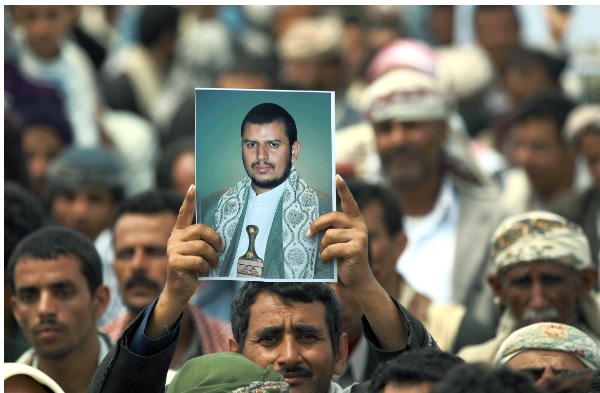
アブドゥルマリク・アル=ハウシー(Abdul-Malik Badruldeen al-Houthi)
アブドゥルマリクは、2014年の燃料補助金を削減への街頭抗議を名目に後の副大統領(Vice President) (r.2016~2022)アリー・ムフシン・アル=アフマル(Ali Mohsen Saleh al-Ahmar) (b.1945) (علي محسن صالح الأحمر)将軍部隊と衝突、戦闘で勝利して首都サヌア(Sana’a /Sanaa) (صنعاء)の支配権を握り、ハーディー大統領辞任と議会解散を強要しました。
In 2014, Abdul-Malik clashed with the forces of Vice President (r.2016~2022) General Ali Mohsen Saleh al-Ahmar (b. 1945) (علي محسن صالح الأحمر) in the name of street protests against cuts to fuel subsidies, winning the battle and taking control of the capital, Sana’a (Sanaa) (صنعاء), forcing President Hadi to resign and dissolve parliament.
2015年1月22日のハウシー派クーデターによるイエメン政府崩壊でハーディー大統領は辞任して監禁されました。サヌアからアデンに脱出したハーディー大統領が、サウジ主導のスンナ派同盟(a coalition of nine Sunni countries led by Saudi Arabia)から支援を得て辞任を撤回して「合法的な大統領に留まっている」と宣言し、反撃した事でイエメン内戦は、再開しました。
President Hadi resigned and was imprisoned following the collapse of the Yemeni government on January 22, 2015 during “Houthi takeover in Yemen (استيلاء الحوثيين على السلطة)”. Yemen’s civil war began when President Hadi, who had fled from Sana’a (صنعاء) to Aden (عدن), was backed by a coalition of nine Sunni countries led by Saudi Arabia, retracted his resignation and declared “he remains a legitimate president”.
対峙する2つの政権の紛争でしたが、2011年以後にアビヤン県(Abyan Governorate) (محافظة أبين)のジンジバール(Zinjibar9 (زنجبار)を初め、領土を確保していた武装組織アンサール・アル=シャリーア(Ansar al-Shari’a) (أنصار الشريعة)を含めて三つ巴の戦いとなりました。アンサール・アル=シャリーアにはアリー・アブドゥッラー・サーレハ(Ali Abdullah Saleh) (علي عبد الله صالح)元大統領派や「アラビア半島のアルカーイダ(Al-Qaeda in Arabian Peninsula) (تنظيم القاعدة في جزيرة العرب) (AQAP)」が加わっていました。
It had been a conflict between the two regimes, but it became a three-pronged battle that includes Zinjibar (زنجبار) in Abyan Governorate (محافظة أبين) after 2011 and the armed group Ansar al-Shari’a (أنصار الشريعة), which had secured territory. Ansar al-Shari’a includes the faction of former President Ali Abdullah Saleh (علي عبد الله صالح) and “Al-Qaeda in Arabian Peninsula (تنظيم القاعدة في جزيرة العرب)” (AQAP).
2015年3月21日にハウシー派主導最高革命委員会(Housi-led Supreme Revolutionary Committee) (اللجنة الثورية العليا التي يقودها الحوثيون)がイエメン政府を継承し、ハウシー派主導の最高革命委員会部隊がアデンに迫ると、ハーディーは国外へ脱出しました。3月26日にハーディー大統領を支援するスンナ派同盟軍が、空爆で「決定的嵐作戦(Operation Decisive Storm) (26 March~21 April 2015) (عملية عاصفة الحزم)」を始め、米国からも軍事情報と物資供給で支援を受けました。7月17日に大統領派はアデン奪回して8月15日にはシャブワ州(Shabwa Governorate) (محافظة شبوة)含め5県を確保して攻勢に転じました。
On March 21, 2015, when Housi-led Supreme Revolutionary Committee (اللجنة الثورية العليا التي يقودها الحوثيون) took over the Yemeni government and unit approached Aden, Hadi fled the country. On March 26, Sunni allies supporting President Abdrabbuh Mansur Hadi (عبدربه منصور هادي) launched Operation Decisive Storm (26 March~21 April 2015) (عملية عاصفة الحزم) with airstrikes, and received military intelligence and supplies from United States. On July 17, the presidency recaptured Aden, and on August 15, it went on the offensive, securing five provinces, including Shabwa Governorate (محافظة شبوة).
2016年10月4日にハウシー派が女性5人や南部出身者含む「救国政府(National salvation government) (حكومة الإنقاذ الوطني)」を樹立する一方で、大統領派の優勢が続き2017年3月26日にハーディー大統領派が「反政府武装勢力支配地域の87%を奪回し、同盟軍の決定的嵐作戦を終了した」と公表しました。しかし、実際にはイランもハウシー派を支援していると言われており、前述の通り内戦は続いていました。
On October 4, 2016, the Houthi’s established a “national salvation government (حكومة الإنقاذ الوطني)” that included five women and people from the South, while the president’s faction continued to prevail, and on March 26, 2017, President Hadi’s faction announced that it had “recaptured 87% of the area controlled by the rebels and ended the coalition’s decisive storm operation.” However, in reality, Iran was also said to be supporting Houthies, and as mentioned above, the civil war continues.

「イエメンの反政府勢力フーシ派が新政府を樹立」ニュー・アラブ紙、2016年11月29日
“Yemen’s Houthi rebels ‘form new government” by The New Arab on 29 November, 2016
サウジアラビアの意向で2022年4月7日のハーディー大統領令により、大統領指導評議会(Presidential Leadership Council) (مجلس القيادة الرئاسي)が、ラシャード・アル=アリーミー(Rashad Muhammad al-Alimi) (رشاد محمد العليمي) を議長(president) (r.2022~present)としてリヤードに設置され、イエメンの全権を掌握してハウシー派との和解が進められてきました。
At the behest of Saudi Arabia, by order of President Hadi of April 7, 2022, Presidential Leadership Council (مجلس القيادة الرئاسي) issued a directive by which Rashad Muhammad al-Alimi (رشاد محمد العليمي) was appointed as president ( R.2022~present). Through the meetings under this council, the reconciliation with Houthies has been progressed with full power for promoting Yemen’s conciliation.
しかし、現実は、南部県の知事5人や政府閣僚も含くむ分離独立派組織である南部暫定評議会(Southern Transitional Council) (المجلس الانتقالي الجنوبي)の議長アイドルース・アッ=ズバイディー(Aidarus al-Zoubaidi) (r.2017~present) (عيدروس الزبيدي)が大統領指導評議会の副議長(Vice president) (r.2022~present)になってい上に、2023年5月の時点で大統領指導評議会の8議席のうち3議席は南部暫定評議会のメンバーが占めるまでに南部暫定評議会は、力を付けて来ています。従って、表面の和平交渉とは異なり、イエメンの内戦は、三つ巴の戦いではなく、南部暫定評議会を含めた四つ巴となっていると思えます。
However, the reality is that Aidarus al-Zoubaidi (عيدروس الزبيدي), chairman (r.2017~present) of Southern Transitional Council (المجلس الانتقالي الجنوبي), a separatist organization that includes five governors of southern governorates and government ministers, is Vice President (r.2022~present) of Presidential Leadership Council , and as of May 2023, three of the eight seats in Presidential Leadership Council are occupied by members of Southern Transitional Council. Therefore, unlike the ostensible peace talks, Yemen’s civil war is not a three-pronged battle, but a four-pronged one, including Southern Transitional Council.

現在(2022年10月)進行中のイエメン内戦における政治的および軍事的支配
Current (October 2022) political and military control in the ongoing Yemeni civil war

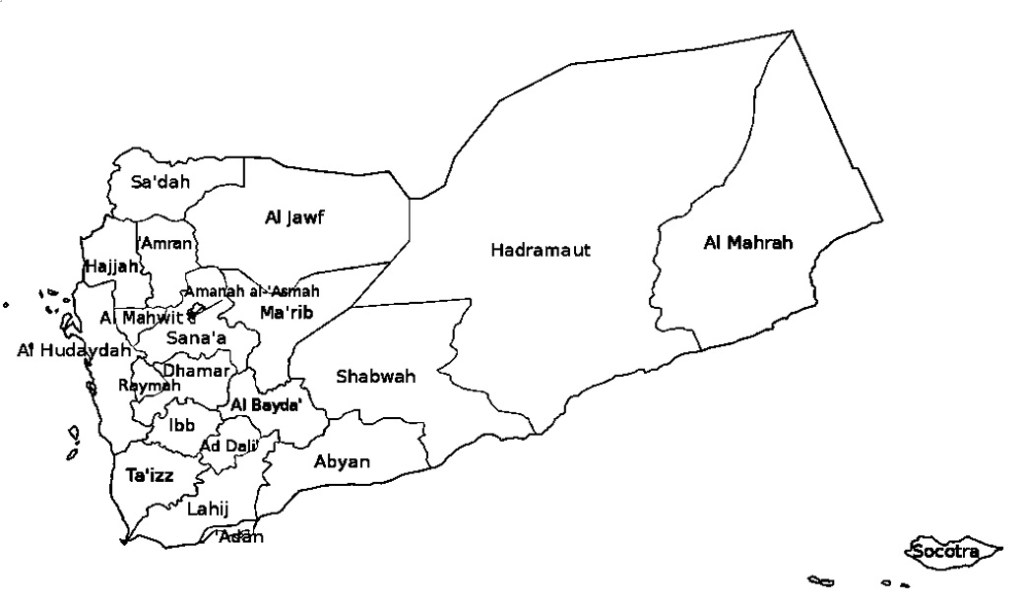
融和の機運
Trend of Reconciliation
一方では、サウジアラビアは、大統領指導評議会を通じてハウシー派と和解しようとしていますし、イランとは2023年6月6日に大使館を開設するまでに国交回復してますし、シリアのアサド大統領は19日、サウジアラビアのジッダで開催されたアラブ連盟の首脳会議に招待を受けて出席して歓迎されています。スンニー派とシーア派は全体的には和解が進んでいます。
On the other hand, Saudi Arabia is trying to reconcile with Hauthi through this Presidential Leadership Council. Saudi’s diplomatic relations with Iran have been restored as the embassy opens on June 6, 2023. Syrian President Bashar al-Assad was welcomed by invitation to attend Arab League summit held at Jeddah (جدة) in Saudi Arabia on June 19. Thus, Sunnis and Shiites are promoting their reconciliatory.
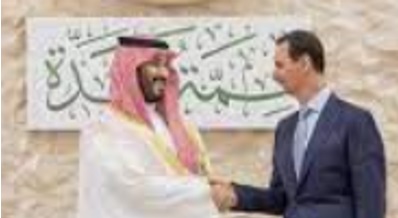
ジェッダでのシリア・アサド大統領 (Syrian President Bashar al-Assad at Jeddah)
さらに、BRICSが2023年8月25日に6つの新規加盟国の中にサウジアラビア、アラブ首長国連邦、イラン、エジプトを招待しました。これにより、この4つのイスラーム国がスンニ派とシーア派の国際政治経済レベルの強力なメンバーとして将来の協力に向けた議論が促進されることになると思われます。
Moreover, BRICS invited Saudi Arabia, United Arab Emirates, Iran and Egypt out of 6 new members on August 25, 2023. This 4 Islam states will expedite the discussion between Sunnis and Shiites for their cooperation in future as the powerful members of the international political and economic level.
BRICs (ブラジル、ロシア、インド、中国) :BRICsは、元々、21 世紀初頭に著しい経済発展を遂げた 4 か国 (ブラジル、ロシア、インド、中国) を総称した言葉です。 2009年以来、BRICs 4カ国は、首脳会議を開催しており、2011年には南アフリカが参加しました。
BRICs は経済連携であり、同盟や連合ではありません。 首脳会議は2009年以来、不干渉、平等、相互利益に基づいて開催されています。
2006 年の時点で、BRICs は、世界の土地面積と人口の圧倒的な割合を占めていました。 割合はそれぞれ29.2%と42.7%でした。
さらに、GDPが世界経済における地位を示す指標である場合、2014年の時点ですでに30.2%を占めています。
2023年8月25日の首脳会議では、アルゼンチン、エジプト、エチオピア、イラン、サウジアラビア、アラブ首長国連邦が2024年1月の会合に参加することが正式に承認され、BRICSは11か国体制となります。 参加を希望する国は少なくないため、近い将来、加盟国はさらに増加すると予想されます。
BRICS (Brazil, Russia, India and China) was originally an umbrella term for four countries (Brazil, Russia, India and China) that experienced significant economic development at the beginning of the 21st century. Since 2009, the four BRICs have held summits, including South Africa in 2011.
BRICs are economic partnerships, not alliances or coalitions. Summit meetings have been held since 2009 on the basis of non-interference, equality and mutual benefit.
As of 2006, the BRICs had made up an overwhelming proportion of the world’s land area and population. The percentages were 29.2% and 42.7%, respectively.
Moreover, if GDP is an indicator of their position in the world economy, then as of 2014 it had already accounted for 30.2%.
At the summit on August 25, 2023, Argentina, Egypt, Ethiopia, Iran, Saudi Arabia and the United Arab Emirates will be officially approved to participate in the January 2024 meeting, bringing the BRICS to an 11-nation structure. Since there are not a few countries wishing to participate, the number of member states is expected to increase in the near future.
